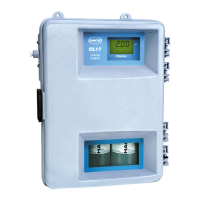Section 2
Page 37
54400_start.fm Instrument Menu Structure
• DIAG OUTPUT—Pressing ENTER will momentarily indicate ON at the
display and any optional LonWorks
®
interfaces present will receive
diagnostic data.
• KEYBOARD LOCKOUT—Press
ENTER then use the ARROW keys to
toggle between ON and OFF. Press
ENTER to select the displayed option.
Press
EXIT to return to the SETUP menu. If the keyboard is locked out, no
editing functions are allowed and all diagnostics are disabled except this
one. The factory default is OFF.
• LANGUAGE—English language is the factory default. Spanish, French,
and German can be enabled. Press
ENTER then use the ARROW keys to
move between the available options. Press the
ENTER key when the
language of choice is displayed. Press the
EXIT key to accept changes
and return to
SETUP.
• DEFAULT SETUP—Cold Start—Press
ENTER to reset the instrument to
factory defaults. All user-specified settings will be lost. The display will
show the software version number (V 1.2 for example) until the next
analysis is complete.
2.7.2 Alarm Setup
This menu accesses two unpowered alarm relays (AL1 and AL2), RECALL
WARNINGS
, and CLEAR WARNINGS. The alarm relays may be assigned to
one of the alarm functions listed below. Only one function can be assigned to
each relay.
•LO—Alarm is triggered if concentration is less than or equal to the trip
point. (0.0 mg/L to 5.0 mg/L limits)
•HI— Alarm is triggered if concentration is greater than or equal to the trip
point. (0.0 mg/L to 5.0 mg/L limits)
• SYSTEM ALARM (SA)—Activates an alarm when a system
alarm occurs.
• SYSTEM WARNING (SW)—Activates an alarm when a system
warning occurs.
In addition, alarm status can be obtained and alarms can be cleared using
this menu.
The relay is activated when an alarm condition occurs. Either relay may be
activated on a high chlorine alarm, a low chlorine alarm or when a System
Warning or System Alarm occurs. Alarm relays can be used to control
chemical feeds as an on/off control, by using them as a high or low alarm
set point.
The two alarm relays can also be used to bracket a specific control range by
adding a double-pole double-throw auxiliary relay and wiring it to electrically
latch. This allows the pump to be turned on at a low level and off at a higher
level—with the concentration dropping down in between.

